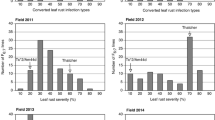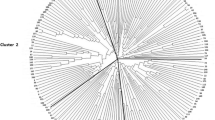Abstract
Comparative genealogical analysis of North American (the United States and Canada) and Eastern European (Russia and Ukraine) winter wheat cultivars resistant and susceptible to common bunt has been performed. Analysis of variance applied to North American wheats has demonstrated that resistant and susceptible cultivars significantly differ from each other with respect to the contributions of common ancestors. The contributions of Oro (Bt4and Bt7), Rio (Bt6), White Odessa (Bt1), and Florence (Bt3) to the resistant cultivars are significantly higher than their contributions to the susceptible ones. This demonstrates that the use of these resistance donors in wheat breeding for several decades has been effective. The contribution of PI-178383 (Bt8, Bt9,and Bt10) is considerably higher in the group of resistant cultivars bred after 1965. The mean contributions of Federation (Bt7) and Nebred (Bt4) are significantly higher in the group of resistant cultivars obtained before 1965; however, the differences in the contributions of these donors between new resistant and susceptible cultivars became nonsignificant. Among the Russian and Ukrainian cultivars, there are differences between groups of resistant and susceptible cultivars from different regions determined by the differences between the regional populations of the pathogen in racial composition. In the northern region, the contributions of the wheat grass (Agropyron glaucum) and the rye cultivar Eliseevskaya are significantly higher in the resistant cultivars; in the southern region, a local cultivar of the Odessa oblast is the prevalent resistant cultivar. In addition, cultivar Yaroslav Emmer is likely to be effective in the northern region; and foreign sources (Oro, Florence, Federation, and Triticum timopheevii), in the southern region. Very few sources of vertical resistance to common bunt are used for winter wheat breeding in Russia and Ukraine. The decrease in genetic diversity in favor of a few identical genes may cause adequate changes in the pathogen population and subsequent proliferation of the pathogen on the genetically identical substrate. A new interpretation of the resistance of line Lutescens 6028 as a source of new genes, Bt12 and Bt13, is suggested. Both genealogical and segregation analyses have shown that the genes determining the resistance of this line may be identical to those described earlier (Bt1, Bt3, Bt4, Bt6, and Bt7); and the high resistance of this line is determined by a combination of these genes.
Similar content being viewed by others
REFERENCES
Martynov, S.P. and Dobrotvorskaya, T.V., Analysis of Wheat Genetic Diversity with the Genetic Resource Information System, GRIS, Genetika (Moscow), 2000, vol. 36,no. 2, pp. 195-202.
Martynov, S.P., Analysis of Genetic Profiles of Winter Wheats from Russia, Euphytica, 1998, vol. 100,nos. 1–3, pp. 305-311.
Rao, C.R., Linear Statistical Inference and Its Applications, New York: Wiley, 1965.
Blazkova, V. and Bartos, P., Reaction of Winter Cultivars Registered in the Czech Republic to Common Bunt (Tilletia tritici Bjerk. and T. laevis Kuehn) and Sources of Resistance, Cereal Res. Commun., 1997, vol. 25,no. 4, pp. 985-992.
Kharakteristiki sortov rastenii, vpervye vklyuchennykh v 1994 godu v Gosudarstvennyi reestr selektsionnykh dostizhenii, dopushchennykh k ispol'zovaniyu (Characteristics of Plant Cultivars First Included in 1994 into a State Catalogue of Breeding Achievements Allowed for Use), Moscow, 1994.
Katalog sortov i gibridov Vsesoyuznogo selektsionnogeneticheskogo instituta (A Catalogue of Cultivars and Hybrids of the All-Union Institute of Breeding and Genetics), Odessa, 1984.
Mozgovoi, A.F. et al., The Gene Pool of Sources and Donors for the Breeding of Winter Common Wheat for Immunity to Stinking Smut, Nauchno-tekh. Byull. Vses. Inst. Rastenievod., 1987, no. 176, pp. 15-20.
Varenitsa, E.T., Kochetygov, G.V., Gradskov, S.M., and Sandukhadze, B.I., Winter Wheat Cultivar Moskovskaya Nizkostebel'naya, Sel. Semenovod., 1990, no. 3, pp. 31-33.
Varenitsa, E.T., Kochetygov, G.V., and Gradskov, S.M., New Cultivars of Winter Wheat, Sel. Semenovod., 1991, no. 5, pp. 39-40.
Katalog sortov sel'skokhozyaistvennykh kul'tur, vpervye predlagaemykh k raionirovaniyu s 1982 g. (A Catalogue of Crop Cultivars First Proposed for Regionalization in 1982), Moscow, 1981.
Katalog vpervye predlagaemykh k raionirovaniyu s 1985 goda sortov sel'skokhozyaistvennykh kul'tur i drugikh vozdelyvaemykh rastenii (A Catalog of Crop and Other Plant Cultivars First Proposed for Regionalization in 1985), Moscow, 1984.
Katalog sortov i gibridov sel'skokhozyaistvennykh kul'tur i drugikh vozdelyvaemykh rastenii, vpervye predlagaemykh k raionirovaniyu s 1990 g. (A Catalog of Crop and Other Plant Cultivars First Proposed for Regionalization in 1990), Moscow, 1989.
Katalog sortov, vpervye predlagaemykh k raionirovaniyu s 1991 goda, sortov i gibridov sel'skokhozyaistvennykh kul'tur (A Catalog of Crop and Other Plant Cultivars First Proposed for Regionalization in 1991), part 1, Moscow, 1990.
Katalog mirovoi kollektsii Vsesoyuznogo Instituta Rastenievodstva (A Catalog of the World Collection of the All-Union Institute of Plant Breeding), issue 256: Sorta i selektsionnye linii ozimoi i yarovoi pshenitsy Krasnodarskogo Nauchno-Issledovate'skogo Instituta Sel'skogo Khozyaistva im. P.P. Luk'yanenko (Winter and Spring Wheat Cultivars and Breeding Lines Obtained in the Krasnodar Research Institute of Agriculture), Puchkov, Yu.M., et al., Eds., Leningrad: Vses. Akad. S-Kh. Nauk, 1979.
Katalog sortov sel'skokhozyaistvennykh kul'tur, vpervye raionirovannykh s 1977 g. (A Catalog of Crops First Regionalized in 1977), Moscow, 1976.
Krivchenko, V.I., Ustoichivost' zernovykh kolosovykh k vozbuditelyam golovnevykh boleznei (Resistance of Cereals to the Pathogens of Smut Diseases), Moscow: Kolos, 1984.
Martynov, S.P. and Dobrotvorskaya, T.V., Genealogical Analysis of the Diversity of Modern Cultivars of Winter Common Wheat, Sel. Semenovod., 2001, nos. 1–2, pp. 47-54.
Novokhatka, V.G., Mochalova, L.I., and Odintsova, I.G., New Wheat Genes Determining Resistance to Stinking and Dwarf Smut (Tilletia carries (DC) Tul., T. laevis Kuehn., T. controversa Kuehn.)), Genetika (Moscow), 1990, vol. 26,no. 10, pp. 1808-1814.
Babayants, L.T. and Dubinina, L.A., A New Donor of Stinking Smut (Tilletia carries (DC) Tul., T. laevis Kuehn.) Resistance in Wheat and Its Genetic Basis, Genetika (Moscow), 1990, vol. 26,no. 12, pp. 2186-2190.
Bunt and Smut Diseases of Wheat: Concepts and Methods of Disease Management, Wilcoxson, R.D. and Saari, E.E., Eds., Mexico: CIMMYT, 1996.
Babayants, L.T., Dubinina, L.A., and Yushchenko, G.M., The Genetic Basis of Stinking Smut (Tilletia carries (DC) Tul.) Resistance in New Wheat Lines, Tsitol. Genet., 1999, vol. 33,no. 6, pp. 25-30.
Manjunath, A. and Nadaf, S.K., A Ready Reckoner of Expected F3 Breeding Behavior Useful in Linkage Studies, Madras Agric. J., 1983, vol. 70,no. 6, pp. 360-365.
Author information
Authors and Affiliations
Rights and permissions
About this article
Cite this article
Martynov, S.P., Dobrotvorskaya, T.V. & Sorokin, O.D. Comparative Genealogical Analysis of the Resistance of Winter Wheat to Common Bunt. Russian Journal of Genetics 40, 410–424 (2004). https://doi.org/10.1023/B:RUGE.0000024979.47710.68
Issue Date:
DOI: https://doi.org/10.1023/B:RUGE.0000024979.47710.68




